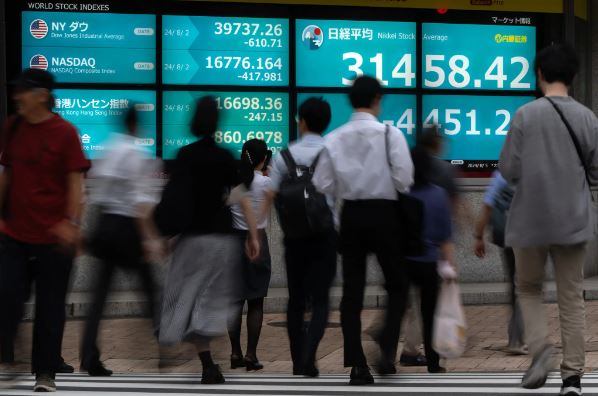Investors in Asia experienced a reprieve on Tuesday following a tumultuous day of global selling sparked by fears of a potential U.S. recession. The recovery was particularly notable in Japan, where the previous day had seen the steepest losses.
In Japan, stocks rebounded significantly after a severe drop on Monday. The Nikkei 225 index rose by 11 percent, recovering some ground after a dramatic 12.4 percent fall the day before. This drop marked the largest single-day decline for the benchmark index, surpassing the infamous Black Monday crash of October 1987.
South Korea also saw a partial recovery. Stocks there, which had plummeted over 10 percent at one point on Monday, regained around 4 percent on Tuesday.
The turmoil in stock markets began last week in Japan, initially triggered by apprehensions about the U.S. economy. These concerns were exacerbated by worries over the impact of a rapidly strengthening yen on corporate profits.
A critical factor was Friday’s U.S. jobs report, which indicated a significant slowdown in hiring. This data prompted a sell-off in U.S. markets, with panic spreading more broadly on Monday. Investors feared that the Federal Reserve might have delayed rate cuts for too long, potentially undermining the strength of the U.S. economy. The S&P 500 on Wall Street fell by 3 percent, marking its sharpest daily decline since September 2022.
The Federal Reserve is anticipated to begin reducing interest rates, currently at a more-than-two-decade high, later this year.
In Japan, market conditions were further complicated by a divergent policy direction. Last Wednesday, the Bank of Japan raised its key interest rate to a quarter of a point, marking only the second rate increase since 2007. For years, Japanese policymakers kept interest rates low to stimulate prices and consumption. However, rising inflation has now prompted them to begin increasing rates.
The prospect of higher interest rates strengthened the yen, a development that could benefit Japan’s economy in the long run but poses a short-term challenge for corporate profits, especially for large companies reliant on exports. The yen’s appreciation unsettled investors, who worried that a stronger currency might end a prolonged rally in Japanese stocks, driven in part by a weaker yen.
A stronger yen also impacted global investments made when the currency was weaker, acting as a catalyst for broader market sell-offs. This selling was further fueled by concerns that stock prices had risen too quickly and too high. A common strategy among some investors involved borrowing in yen and investing in markets like the U.S. However, as the dollar’s strength began to wane this year, the profitability of that trade diminished, leading to further market instability.
On Tuesday, the yen weakened, trading at approximately 145 to the dollar, compared to 141 the previous day.
While the immediate market reaction to the strengthening yen and subsequent stock declines appears to have subsided, analysts caution that significant market fluctuations are likely to persist. These fluctuations are expected until there is more clarity regarding the direction of the U.S. economy.
The situation highlights the interconnectedness of global financial markets and the ripple effects that policy changes in one major economy can have worldwide. As the Federal Reserve moves closer to potential rate cuts and the Bank of Japan navigates its policy adjustments, investors will be closely monitoring economic indicators and central bank communications for signals of future trends.
In the meantime, the recovery in Asian markets provides a temporary respite, but the underlying concerns about global economic stability remain. Investors will need to remain vigilant and adaptable as they navigate the ongoing uncertainty and potential volatility in the markets. The balance between inflation control and economic growth continues to be a delicate and critical issue for policymakers worldwide.

